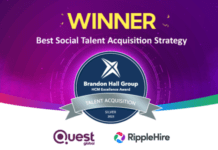Organisations are investing in blended and digital learning, which is a really good thing. What isn’t so good, however, is how that investment is happening. What we’re seeing at Hemsley Fraser is that some organisations are almost working through a digital learning shopping checklist, rather than thinking holistically about what is required, how it’ll be deployed or even why it is important. Much of the focus is seemingly on short-term fixes. This needs to change. It is really important that organisations understand and evaluate the future potential of digital solutions and the impact on learners before they purchase or implement anything new.
Problems arise when organisations rush into purchases without performing due diligence or properly understanding what the impact may be. This happens when organisations are stuck in the ‘here’ and ‘now’, crossing off things on their generic checklist. We need a platform: check, got that. We need to buy content: check, got that. We have staff working on our LMS who can upload stuff: check, got that…and so on. This is just short-term thinking. Instead of taking this approach, there needs to be a focus on the really important stuff, such as the experience of the learner, how learning can drive engagement and the real value that great learning offers to both learners and the business, now and in the future.
Step1: Be aware of the technology lifecycle
This means taking a step back and thinking beyond the next procurement cycle. Work on a five-year plan keeping in mind the current and future needs of the whole business.
A future-proofed, flexible tech solution is crucial when considering long-term value. While it’s important to think about the look and feel of a digital product, it’s more important to choose a flexible solution that can keep pace with the ever-changing rhythms of business and learner needs.
Step2: Understand the total cost of ownership
This part of the decision-making process is often overlooked. Organisations need to balance the cost of buying, maintaining and updating a solution against the value that solution will bring. Calculating that value is very hard when organisations aren’t sure what it is they want to measure their value against. A good starting place is to understand how much it costs to provide digital learning to each staff member and then how effective that learning is at achieving the desired improvements. Hemsley Fraser focuses on what it calls ‘digital engagement’, which is a measure of how staff members interact in a meaningful way with the content. You’d be surprised at how low the digital engagement score is across the industry as a whole — it’s usually less than10 per cent, which means that less than 10 per cent of the people with access to digital learning are accessing it, with potentially even fewer benefiting from it. With the right platform and communication strategy, this engagement score can increase significantly up to 35 per cent.
For an organisation of 10,000 learners, that means an extra 2,500 people benefiting from a digital solution. And if both solutions cost the same, the one with up to 35 per cent engagement is giving at least 25 per cent better value!
Step 3: Create a five-year vision for learning
Organisations need to create a strong, clear vision of what great learning looks like over the next one to five years. Know what will drive real value to learners and the organisation. Communicate with people all around the business and get their perspective on what great learning can and should look like. Think about what they see and use as consumers in their leisure time. They’re used to personalised, intuitive, user-friendly content and functionality — YouTube, Netflix, Spotify, and so on – and they’re going to want that in the workplace too. The painfully low engagement scores quoted above are symptomatic of ignoring this crucial element.
T: +91 22 25646002 W: www.atiitya.com
E: info@atiitya.com
Step 4: Use data to make better decisions
Take what tech has to offer— collect and use data to identify what the learning challenges are, where engagement is strong and where it is weak. Data is a fantastic resource that L&D must use more. For instance, analytics can show us how well a piece of learning or a piece of communication landed. Here, at Hemsley Fraser, if the Board sends out a message on our engagement hub, we can see how many people have watched it and engaged with it. That’s really useful information because it means we can carry out additional actions if we need to follow up and engage with our employees, based on that information. Technology can help us make smarter decisions. It can also help us communicate those decisions more effectively. Meaningful data is a great communication tool and can really help L&D get the business on board with its vision.
Step 5: Develop your communication skills
Communication is key to implementing a successful digital learning strategy and the communication needs to be two-way. You listen to what learners and the business say and you explain how learning can meet their needs, using the data you have. As a modern-day L&D professional, you have to be an excellent communicator — an influencer and a facilitator. You have to use all the communication channels at your disposal to drive support for and excitement around the solutions you are implementing. The more buzz there is, the more people will use it. Tell people why they should use this new platform and sell it to them. Be clear on what they will gain from using the platform. If they will gain more insight into what the organisation is trying to achieve, tell them that. If it’s the skills and behaviours needed to achieve those goals, tell them that too.
Step 6: Call out the technology fads
Senior leaders may be unwilling to make the investment just yet and you may have to break your journey down into phases. If your organisation isn’t ready to commit to your transformation vision, then make sure that any step(s) you take, or any purchase(s) you make, support where you want to end up. Don’t be seduced by shiny new toys and fads that will only be a short-term fix. Make sure your phased investments help get you to your destination.
Gamification is a good example. Many organisations love gamification and it can be brilliant, but you have to use it properly to get results. What is the value to an organisation if 200 people have a gold badge, for instance? Will it make a difference to the bottom line? There has to be a balance between trying to get people engaged and understanding what the drivers for engagement are in your organisation and how that engagement turns into value.
It comes back to knowing why you are doing something and how the learning will drive learner engagement and performance and thereby, business performance. Ensuring all your procurement decisions are aligned to the longer-term plan, rather than the one-budget cycle, means you hopefully won’t end up down a blind alley or spending twice as much for something than you intended.
When procurement is tied to the overall vision, that’s when you get real results. Technology should be scalable. You need to make sure everything is future-proofed and will help you deliver on your vision over the next five years. And when the business starts to see the difference the learning is making, then it becomes easier to win them over to your way of thinking.
The exec team often wants to fit digital into the same mould that the organisation has occupied for many years.
Digital solutions should drive pace and efficiencies in a business.
It is the same for L&D. Learning has to be different now, as learning is more holistic and isn’t just about learning soft or technical skills. It needs to be broader to include communication of key information and a sense of its organisation and its culture. Technology enables us to do different and really clever things. Sometimes, the business needs nudging in the right direction — you need to get them to think differently by showing them the real future.
Value our content... contribute towards our growth. Even a small contribution a month would be of great help for us.
Since eight years, we have been serving the industry through daily news and stories. Our content is free for all and we plan to keep it that way.
Support HRKatha. Pay Here (All it takes is a minute)




































